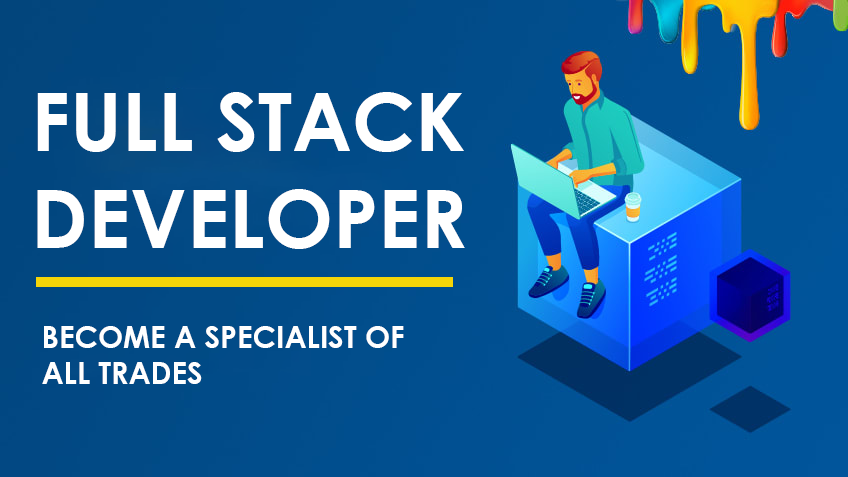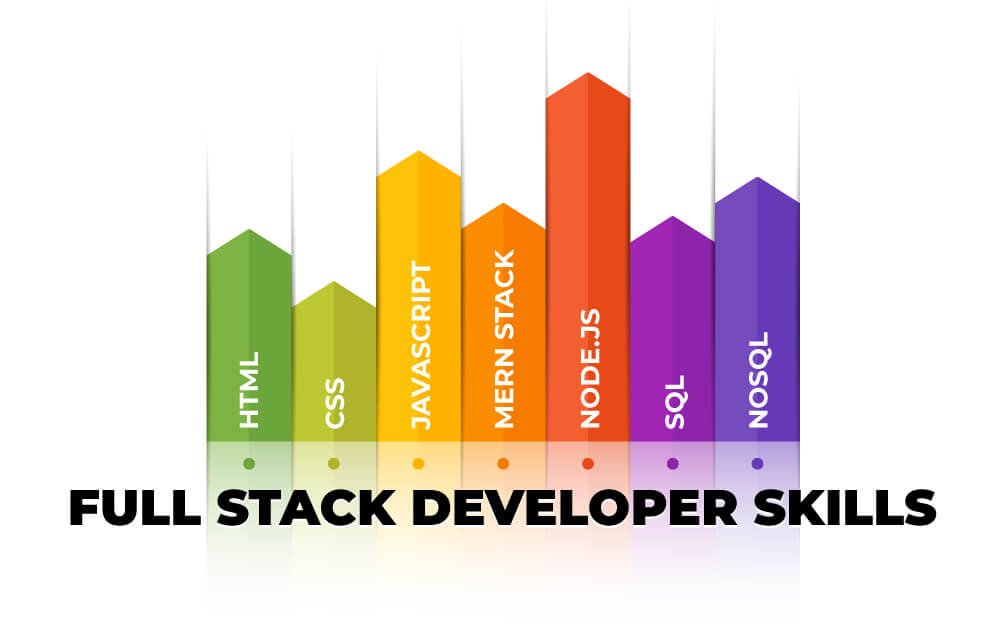

Boasting attractive pay-scales and growth potential, full stack developers have become some of the most desirable professionals in the world. A profession that stands out in the IT industry for its multifaceted nature, full stack development is a holistic engineering practice that tends to all aspects of web development.

The processes involved in the development of a software application mainly fall into two categories: front-end development and back-end development.
Front-end development takes care of the client’s side of the application; a front-end developer makes sure the end product is visually appealing and user-friendly.
Back-end development powers the server-side of the application; a back-end developer is responsible for using the programming language to exchange information between the browser and back-end databases.
A full stack development professional is the one who has sound technical knowledge of the key elements of development –
Among other details of the technology, Full stack web development is a sought-after career option today. Companies actively seek developers who have sound specializations in these multiple fields.
However today, the definition of full stack is quite dynamic and in some aspects company-specific too.
So, the real question running on your mind and others likewise is - how to master both simultaneously, and is it difficult to be a master of both?
Well, yes and no.

Initially, mastering both backend and frontend together is futile as you will leave out the chance of thoroughly understanding either one and end up sabotaging both stacks.
The best way to become a full stack developer is to specialize in either Frontend or Backend while having a working knowledge of the other and then keep improving the other part over time.
Adopting this method will enable you to collaborate on projects early-on. Companies follow their own tech stacks and you should be in a position to shift to their tech stack from your working stack.
Big-tech companies like Google, Amazon, Facebook, have big project teams and if you are specialized in either frontend or backend only, you can still work your way into such product based companies.

The key elements that define a full stack developer are as follows. Mastering these skills as a bundle is what makes a developer truly ‘Full Stack’.
Frontend Development (The Picasso)
This is the client-side part i.e. the part of the website a user sees and interacts with. A developer needs to get creative and innovative with graphics and designs for this part. UI/UX is a challenging task in itself and a crucial task.
The main technologies required for frontend development are HTML5, CSS3, and JavaScript (ES6). For the real bang you need to use jQuery, Angular, ReactJs, etc. like libraries/frameworks to make your website trendy!
Backend Development (The Socrates)
This is the brains of the application/product and honestly it needs some brains to build the backend of an application. All the crazy things that your application should be able to do is be scripted on this side of the app i.e. the server-side. Accessing and using database, user authentication, validation, etc. are some of the many things needed to be done here.
Backend developers build and maintain the server-side technology needed to power the components which enable the user-facing side of the website to exist. This includes the core application logic, databases, data and application integration, API and other backend processes.
If you are looking to hone popular technologies used in backend development, make sure you have a solid understanding of all the concepts covered in Crio's Backend Developer Track curriculum.
Databases
To store and retrieve data we need a database right? There are two types of databases - relational and non-relational (SQL vs NoSQL).
Developers should be familiar with both types of databases such as MySQL, PostgreSQL, MongoDB, Cassandra. Additionally, knowledge of caching options such as Redis, Memcached, and Varnish is an absolute plus!
Version Control System
Every product/application goes through many versions and revisions before getting compiled and deployed. A version control system should be learned and used like GitHub (popular), GitLab, Apache Subversion.
Using version control is a common practice and one of the good habits for a developer to have.
Among other things a full stack developer should know
Developers should know how to use the command line, different operating systems (specifically Linux-based), deployment methods offered by different cloud services like AWS, GCP, Microsoft Azure, etc.

Let’s get this cleared first. Here are the top 3 reasons why you should consider becoming a full stack developer –
Building unique proprietary software products
Every company/developer follows their own tech stack while building a product (as every product has its own requirements and the best set of technology is chosen accordingly).
The use of such diverse technologies makes the code base of the project complex and this eventually creates a unique code for a particular product. Companies adopting full stack development will have this edge.
A huge arsenal of web technologies ensures cutting-edge product development
Full stack developers have working experience of several frontend and backend technologies (languages and frameworks) like HTML, CSS, JS, Python, Ruby, PHP, more.
This diverse working knowledge gives developers the flexibility to tailor the tools needed for the project as per the project needs and create a state of the art products; since every technology has something different to offer – broadly in terms of syntaxes, compiling time (performance), compatibility, code reusability.
One fine example is that web developers with frontend knowledge can easily convert animations and graphics offered by software like Adobe Photoshop directly to frontend code. Thereby reducing the dependency on such third-party proprietary software. Limiting knowledge of basic styling tools will bind the developer to use such third-party software and thus burdening the project’s budget. Similar advantages apply to backend scenarios. And thus knowing several essential tools will open up innovative approaches to projects.
Knowing full stack offers rapid growth in job role
To be a project manager (generally the top of the hierarchy of a project team) knowing full stack web development is helpful as you should be able to assimilate both frontend and backend mainly amongst the other tasks like database management or cloud services. Becoming a niche developer may often lead you to crossroads in your projects and due to this companies often avoid such developers.

MERN stack

Want to master full stack web development? Then dig right into this one!
LAMP stack

You may start with this old school tech stack, but do not wind yourself up too much around this one ;)
MEAN stack

Want to develop robust applications? Then try this one out.
It is a recommended practice to begin your full stack journey with frontend and progressively move into backend. This is so because in this elaborate learning process for the momentum to be there, the start should be exciting at least.
You can see all moving parts while developing a site’s frontend which instills fun and motivation. While the backend is usually complex and requires some critical thinking to perceive it, it often becomes a bummer for full stack beginners.

You’ll typically see a mix of front and back end skills listed on full stack web developer job listings, including:
Ideally, some knowledge of web or visual design, plus user experience best practices.

The average full stack developer salary in the United States is $112,000 per year, according to the 2020 Stack Overflow survey(opens in a new tab). That’s compared to $120,000 per year for back end developers and $110,000 for front end developers.
Meanwhile, Indeed says that on average full stack engineers make between $90,000-$130,000, so there’s plenty of room to increase your salary as you gain experience.
It’s important to note, though, that while a site like Indeed lists over 16,000 full stack web developer jobs, it also currently lists over 13,000 front end positions and an average salary of $95,000 — meaning you’re not limiting your options by focusing on front end skills to start with.
On a final note
A full-stack developer has all the keys to the house–there is no door that you cannot open. It provides an unparalleled freedom to simultaneously work on frontend and backend development and evaluate the capabilities and potential of your website in real-time without having to wait for another developer to review if what you’re desiring is possible or not.
In short, you become a master of the internet. And as our research shows, you should expect an impressive salary to match.
Interested in becoming a full-stack web developer? Or perhaps you’d like to specialize in frontend or backend development? BIT teaches Full stack web development courses that start from the beginning, and go all the way to professional. We’re proud to be one of the most affordable and high quality Full stack web development courses available.
Copyright Bitonlinelearn © 2021. All Rights Reserved | Design and Developed By BITINFOTECH